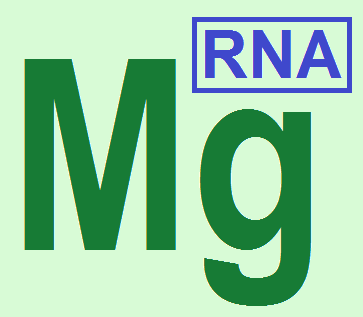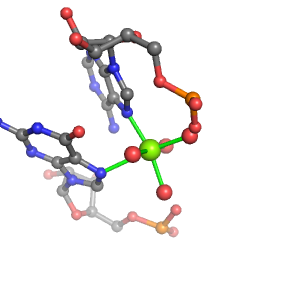| Mg2+ ion |
Site type |
Inner-sphere ligands |
Outer-sphere ligands |
|---|
| PDB ID |
Mg2+ ID |
Oph |
Or |
Ob+Nb |
Water |
Other |
Pout |
Rout |
Bout |
|
2i2t |
B2932 |
2Nb |
|
|
G:B1358(N7), G:B1371(N7) |
B3156, B3157, B3158, B3159 |
|
G:B1358, C:B1357, C:B1370 |
|
|
|
2i2t |
B2959 |
2Nb |
|
|
G:B733(N7), A:B761(N7) |
B3284, B3285, B3286, B3287 |
|
A:B761, G:B733, G:B760, C:B732 |
|
|
|
2i2u |
A1560 |
2Nb |
|
|
G:A858(N7), G:A869(N7) |
A1682, A1683, A1684, A1685 |
|
G:A869, G:A858, C:A868, C:A857 |
|
|
|
2i2v |
B2921 |
2Nb |
|
|
G:B733(N7), A:B761(N7) |
B3106, B3107, B3108, B3109 |
|
G:B733, G:B760, A:B761, C:B732 |
|
|
|
2i2v |
B2941 |
2Nb |
|
|
G:B1358(N7), G:B1371(N7) |
B3205, B3206, B3207, B3208 |
|
G:B1371, G:B1358, C:B1357, C:B1370 |
|
|
|
2otj |
08011 |
2Nb |
|
|
G:0824(N7), G:0854(N7) |
03987, 04323, 04452, 04558 |
|
G:0854, G:0824, U:0823, C:0853 |
|
|
|
2qal |
A2187 |
2Nb |
|
|
G:A858(N7), G:A869(N7) |
A2188, A2189, A2190, A2191 |
|
G:A858, G:A869, C:A868 |
|
|
|
2qam |
B3321 |
2Nb |
|
|
G:B733(N7), A:B761(N7) |
B3873, B3874, B3875, B3876 |
|
A:B761, G:B760, G:B733 |
|
|
|
2qao |
B3099 |
2Nb |
|
|
G:B733(N7), A:B761(N7) |
B3699, B3700, B3701, B3702 |
|
A:B761, G:B760, G:B733 |
|
|
|
2qao |
B3220 |
2Nb |
|
|
G:B1358(N7), G:B1371(N7) |
B3800, B3801, B3802, B3803 |
|
G:B1371, G:B1358, C:B1357, C:B1370 |
|
|
|
2qb9 |
A2187 |
2Nb |
|
|
G:A858(N7), G:A869(N7) |
A2509, A2510, A2511, A2512 |
|
G:A858, G:A869, C:A868 |
|
|
|
2qba |
B3321 |
2Nb |
|
|
G:B733(N7), A:B761(N7) |
B3873, B3874, B3875, B3876 |
|
A:B761, G:B760, C:B732, G:B733 |
|
|
|
2qba |
B3164 |
2Nb |
|
|
G:B1358(N7), G:B1371(N7) |
B3745, B3746, B3747, B3748 |
|
G:B1358, G:B1371, C:B1357 |
|
|
|
2qbb |
A2213 |
2Nb |
|
|
G:A858(N7), G:A869(N7) |
A2545, A2546, A2547, A2548 |
|
G:A869, G:A858, C:A868, C:A857 |
|
|
|
2qbc |
B3099 |
2Nb |
|
|
G:B733(N7), A:B761(N7) |
B3701, B3702, B3703, B3704 |
|
A:B761, G:B733, G:B760, C:B732 |
|
|
|
2qbd |
A2187 |
2Nb |
|
|
G:A858(N7), G:A869(N7) |
A2188, A2189, A2190, A2191 |
|
G:A858, G:A869, C:A868 |
|
|
|
2qbe |
B3321 |
2Nb |
|
|
G:B733(N7), A:B761(N7) |
B3873, B3874, B3875, B3876 |
|
A:B761, G:B760, C:B732, G:B733 |
|
|
|
2qbf |
A1576 |
2Nb |
|
|
G:A858(N7), G:A869(N7) |
A1777, A1778, A1779, A1780 |
|
G:A869, G:A858, C:A868, C:A857 |
|
|
|
2qbg |
B2941 |
2Nb |
|
|
G:B1358(N7), G:B1371(N7) |
B3199, B3200, B3201, B3202 |
|
G:B1371, G:B1358, C:B1357, C:B1370 |
|
|
|
2qbg |
B2921 |
2Nb |
|
|
G:B733(N7), A:B761(N7) |
B3098, B3099, B3100, B3101 |
|
A:B761, G:B733, G:B760, C:B732 |
|
|
|
2qbh |
A1573 |
2Nb |
|
|
G:A858(N7), G:A869(N7) |
A1750, A1751, A1752, A1753 |
|
G:A858, G:A869, C:A868 |
|
|
|
2qbi |
B2932 |
2Nb |
|
|
G:B1358(N7), G:B1371(N7) |
B3147, B3148, B3149, B3150 |
|
G:B1358, G:B1371, C:B1357, C:B1370 |
|
|
|
2qbi |
B2959 |
2Nb |
|
|
G:B733(N7), A:B761(N7) |
B3273, B3274, B3275, B3276 |
|
A:B761, G:B733, G:B760, C:B732 |
|
|
|
2qbj |
A1576 |
2Nb |
|
|
G:A858(N7), G:A869(N7) |
A1775, A1776, A1777, A1778 |
|
G:A869, G:A858, C:A868, C:A857 |
|
|
|
2qbk |
B2941 |
2Nb |
|
|
G:B1358(N7), G:B1371(N7) |
B3195, B3196, B3197, B3198 |
|
G:B1371, G:B1358, C:B1357, C:B1370 |
|
|
|




